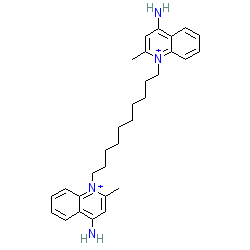|
Compound class:
Synthetic organic
Comment: While the INN-assigned preparation of dequalinium is in complex with chloride, the compound is also available experimentally as the 'parent' salt form. Two of the references listed here [1,4] refer to the parent compound, while [5] and [6] refer to dequalinium chloride. We show the structure of the parent compound, and our external links are also to this structure.
Ligand Activity Visualisation ChartsThese are box plot that provide a unique visualisation, summarising all the activity data for a ligand taken from ChEMBL and GtoPdb across multiple targets and species. Click on a plot to see the median, interquartile range, low and high data points. A value of zero indicates that no data are available. A separate chart is created for each target, and where possible the algorithm tries to merge ChEMBL and GtoPdb targets by matching them on name and UniProt accession, for each available species. However, please note that inconsistency in naming of targets may lead to data for the same target being reported across multiple charts. ✖ |
|
|||||||||||||||||||||||||||||||||||
| References |
|
1. Dreixler JC, Bian J, Cao Y, Roberts MT, Roizen JD, Houamed KM. (2000)
Block of rat brain recombinant SK channels by tricyclic antidepressants and related compounds. Eur J Pharmacol, 401 (1): 1-7. [PMID:10915830] |
|
2. Rosenbaum T, Gordon-Shaag A, Islas LD, Cooper J, Munari M, Gordon SE. (2004)
State-dependent block of CNG channels by dequalinium. J Gen Physiol, 123 (3): 295-304. [PMID:14981138] |
|
3. Rosenbaum T, Islas LD, Carlson AE, Gordon SE. (2003)
Dequalinium: a novel, high-affinity blocker of CNGA1 channels. J Gen Physiol, 121 (1): 37-47. [PMID:12508052] |
|
4. Shah M, Haylett DG. (2000)
The pharmacology of hSK1 Ca2+-activated K+ channels expressed in mammalian cell lines. Br J Pharmacol, 129 (4): 627-30. [PMID:10683185] |
|
5. Strøbaek D, Jørgensen TD, Christophersen P, Ahring PK, Olesen SP. (2000)
Pharmacological characterization of small-conductance Ca(2+)-activated K(+) channels stably expressed in HEK 293 cells. Br J Pharmacol, 129 (5): 991-9. [PMID:10696100] |
|
6. Terstappen GC, Pula G, Carignani C, Chen MX, Roncarati R. (2001)
Pharmacological characterisation of the human small conductance calcium-activated potassium channel hSK3 reveals sensitivity to tricyclic antidepressants and antipsychotic phenothiazines. Neuropharmacology, 40 (6): 772-83. [PMID:11369031] |







